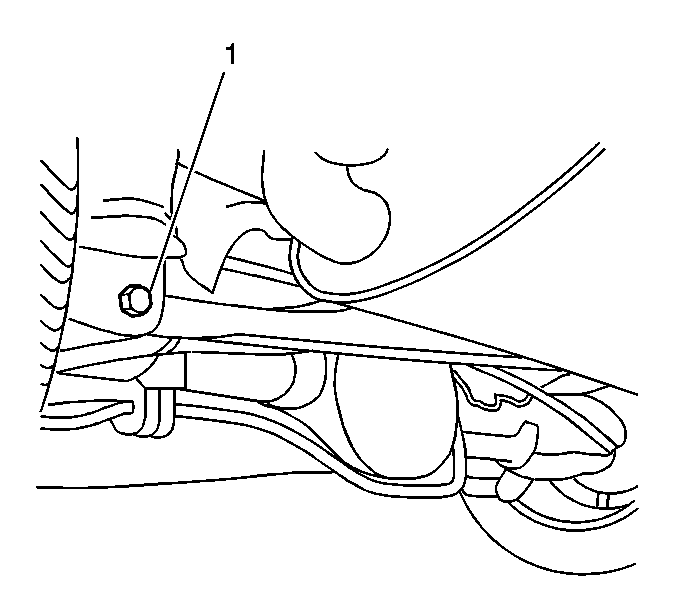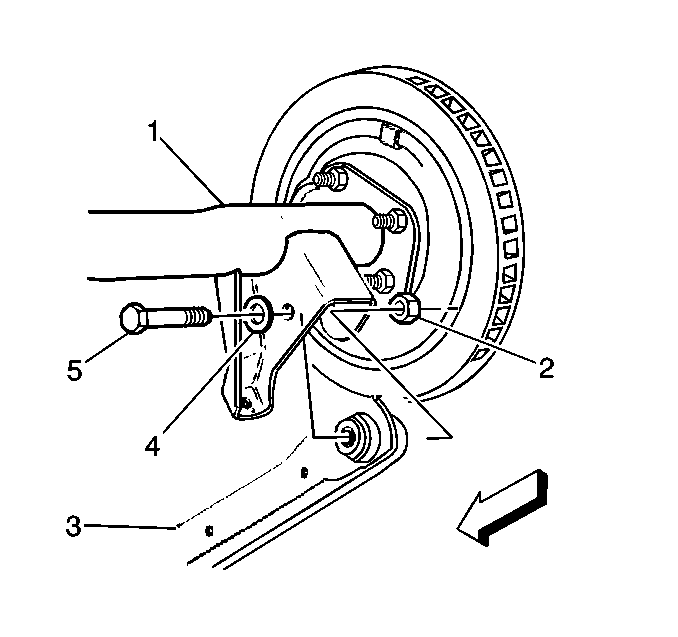Removal Procedure
- Raise and support the vehicle. Refer to Lifting and Jacking the Vehicle in General Information.
- Remove the rear tire and wheels assemblies. Refer to Tire and Wheel Removal and Installation in Tires and Wheels.
- Remove the propeller shaft. Refer to One-Piece Propeller Shaft Replacement or Two-Piece Propeller Shaft Replacement in Propeller Shaft.
- Remove the rear stabilizer shaft. Refer to Stabilizer Shaft Replacement in Rear Suspension.
- Use an adjustable lifting device in order to support the rear axle housing.
- Remove the tie rod-to-rear axle bolt (1) and nut.
- Remove the rear brake center hose from the rear brake hose junction block. Refer to Rear Brake Hose Replacement in Hydraulic Brakes.
- Remove the rear springs. Refer to Coil Spring Replacement in Rear Suspension.
- Disconnect the parking brake cables from the rear axle housing and the park brake actuators. Refer to Parking Brake Rear Cable Replacement in Park Brake.
- Disconnect the electrical connector from the rear wheel speed sensor.
- Remove the rear axle torque arm. Refer to Torque Arm Replacement in Rear Suspension.
- Remove the lower control arm-to-rear axle bolts (5), washers (4), and nuts (2).
- With the aid of a helper, remove the rear axle housing.


Installation Procedure
- With the aid of a helper, install the rear axle housing.
- Install the lower control arm-to-rear axle bolts (5), washers (4), and nuts (2).
- Install the rear axle torque arm. Refer to Torque Arm Replacement in Rear Suspension.
- Connect the electrical connector to the rear wheel speed sensor.
- Connect the parking brake cables to the rear axle housing and the park brake actuators. Refer to Parking Brake Rear Cable Replacement in Park Brake.
- Install the rear springs. Refer to Coil Spring Replacement in Rear Suspension.
- Install the rear brake center hose to the rear brake hose junction block. Refer to Rear Brake Hose Replacement in Hydraulic Brakes.
- Install the rear tie rod-to-axle bolt (1) and nut.
- Remove the adjustable lifting device from the rear axle housing.
- Install the rear stabilizer shaft. Refer to Stabilizer Shaft Replacement in Rear Suspension.
- Install the propeller shaft. Refer to One-Piece Propeller Shaft Replacement or Two-Piece Propeller Shaft Replacement in Propeller Shaft.
- Bleed the brake system. Refer to Hydraulic Brake System Bleeding in Hydraulic Brakes.
- Install the rear tire and wheels assemblies. Refer to Tire and Wheel Removal and Installation in Tires and Wheels.
- Inspect the rear axle lubricant level. Refer to Lubricant Level Check .
- Lower the vehicle.
- Road test the vehicle in order to ensure proper rear axle operation.

Notice: Use the correct fastener in the correct location. Replacement fasteners must be the correct part number for that application. Fasteners requiring replacement or fasteners requiring the use of thread locking compound or sealant are identified in the service procedure. Do not use paints, lubricants, or corrosion inhibitors on fasteners or fastener joint surfaces unless specified. These coatings affect fastener torque and joint clamping force and may damage the fastener. Use the correct tightening sequence and specifications when installing fasteners in order to avoid damage to parts and systems.
Tighten
Tighten the lower control arm-to-rear axle bolts to 118 N·m
(87 lb ft)

Tighten
Tighten the rear tie rod-to-axle bolt to 118 N·m (87 lb ft)
